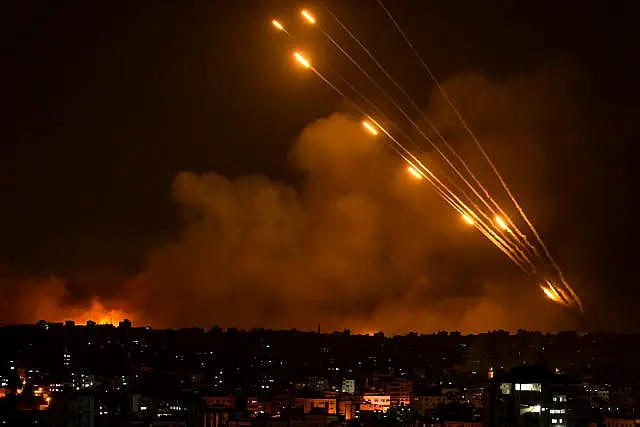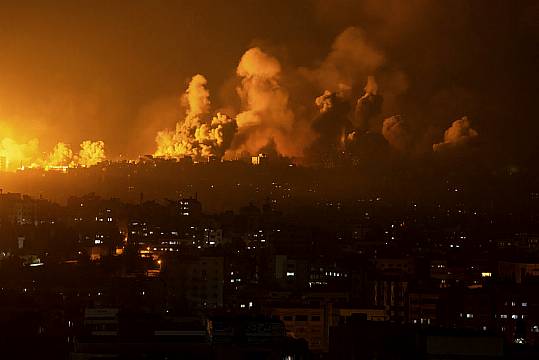The Israeli government formally declared war on Sunday and gave the green light for “significant military steps” to retaliate against Hamas for its surprise attack.
The declaration came as the military tried to crush fighters still in southern towns and intensified its bombardment of the Gaza Strip.
The toll passed 1,000 dead and thousands wounded on both sides.
More than 24 hours after Hamas launched its unprecedented incursion out of Gaza, Israeli forces were still trying to defeat the last groups of militants holed up in several towns.

At least 700 people have reportedly been killed in Israel, a staggering toll on a scale the country has not experienced in decades, and more than 300 have been killed in Gaza as Israeli airstrikes pound the territory.
The Israeli rescue service Zaka said its paramedics removed about 260 bodies from a music festival attended by thousands that came under attack.
The total figure is expected to be higher as other paramedic teams were working in the area.
Video on social media and Israeli news outlets showed dozens of festivalgoers running through an open field as gunshots rang out. Many hid in nearby fruit orchards or were gunned down as they fled.
The declaration of war portended greater fighting ahead, and a major question was whether Israel would launch a ground assault into Gaza, a move that in the past has brought intensified casualties.

Meanwhile, in northern Israel, a brief exchange of strikes with Lebanon’s Hezbollah militant group fanned fears that the fighting could expand into a wider regional war.
Authorities were still trying to determine how many civilians and soldiers were seized by Hamas fighters during the mayhem and taken back to Gaza.
From videos and witnesses, the captives are known to include women, children and the elderly.
The leader of the Palestinian Islamic Jihad group, Ziad Nakhaleh, said his group, which took part in the attack, is holding more than 30 Israelis, among dozens he said were captive in Gaza.
He said they would not be released until all Palestinian prisoners in Israeli jails are freed.
Senior Hamas official Mousa Abu Marzouk told Arabic language news outlet al-Ghad on Sunday that they were holding more than 100 people captive.
During their rampage through southern Israel, militants dragged back into Gaza dozens of captives, among them women, children and the elderly.
Their precise number had not been clear until the two militant groups made their announcements.
US secretary of state Antony Blinken said as many as 1,000 Hamas fighters were involved in the assault, a high figure that underscored the extent of planning by the militant group ruling Gaza.
The gunmen rampaged for hours, gunning down civilians in towns, along roads and at a techno music festival being held in the desert near Gaza.
בחמ״ל חיל האוויר. ישראל תנצח 🇮🇱 pic.twitter.com/ta5RTU5yf7
— Benjamin Netanyahu - בנימין נתניהו (@netanyahu) October 8, 2023
Israel has hit more than 800 targets in Gaza so far, its military said, including airstrikes that levelled much of the town of Beit Hanoun in the enclave’s northeast corner.
Warplanes fired tons of explosives on 120 targets, Israeli Rear Admiral Daniel Hagari told reporters, saying Hamas was using the town as a staging ground for attacks.
There was no immediate word on casualties, and most of the community’s population of tens of thousands of people are likely to have fled before the bombardment.
“We will continue to attack in this way, with this force, continuously, on all gathering (places) and routes” used by Hamas, Hagari said.
Civilians on both sides were already paying a high price.
A line of Israelis snaked outside a central Israel police station to supply DNA samples and other means that could help identify missing family members.

Israeli TV news aired a stream of accounts from relatives of captive or missing Israelis who wept and begged for assistance and information.
In Gaza, the tiny enclave of 2.3 million people sealed off by an Israeli-Egyptian blockade for 16 years since the Hamas takeover, residents feared an intensified onslaught.
Israeli strikes flattened a number of residential buildings. Some 74,000 displaced Gazans were staying in 64 shelters, with the number expected to increase.
The UN agency for Palestinian refugees, UNWRA, said a school sheltering more than 225 people took a direct hit. It did not say where the fire came from.
Several Israeli media outlets, citing rescue service officials, said at least 700 people have been killed in Israel, including 44 soldiers.
The Gaza health ministry said 313 people, including 20 children, were killed in the territory.

Some 2,000 people have been wounded on each side.
An Israeli official said security forces have killed 400 militants and captured dozens more.
The exchange of fire with Hezbollah added to concern that the conflict could spread.
Hezbollah fired dozens of rockets and shells on Sunday at three Israeli positions in a disputed area along the border, and the Israeli military fired back using armed drones.
Iranian-backed Hezbollah is estimated to have tens of thousands of rockets at its disposal.
Since its brutal 2006 war with Israel, Hezbollah has stayed on the sidelines amid previous outbreaks of Israeli-Hamas fighting. But if destruction in Gaza escalates, it may feel pressure to intervene.

The security cabinet also approved “significant military steps”. The steps were not defined, but the declaration appears to give the military and prime minister Benjamin Netanyahu a wide mandate.
Speaking on national television on Saturday, Mr Netanyahu vowed that Hamas “will pay an unprecedented price”. He further warned: “This war will take time. It will be difficult.”
In a statement, his office said the aim will be the destruction of Hamas’ “military and governing capabilities” to an extent that prevents it from threatening Israelis “for many years”.
Israelis were still reeling from the breadth, ferocity and surprise of the Hamas assault.
The group’s fighters broke through Israel’s security fence surrounding the Gaza Strip early on Saturday.
Using motorcycles and pickup trucks, even paragliders and speedboats on the coast, they moved into nearby Israeli communities – as many as 22 locations.

The high death toll and slow response to the onslaught pointed to a major intelligence failure and undermined the long-held perception that Israel has eyes and ears everywhere in the small, densely populated territory it has controlled for decades.
The Israeli military was evacuating at least five towns close to Gaza and then scouring them for militants.
Much of the territory’s population was thrown into darkness on Saturday night as Israel cut off electricity and said it would no longer supply power, fuel or other goods to the territory.
One woman sheltering at an UNWRA school in Gaza City’s Sheikh Radwan neighbourhood described a panicked flight from her home in the middle of the night. The Israeli military made announcements on loudspeakers telling people to leave.
“We didn’t know where to go,” she said. “It was a miracle we arrived at the schools because there was no transport.”
The presence of hostages in Gaza complicates Israel’s response. Hamas officials have said they will seek the release of thousands of Palestinian prisoners, and Israel has a history of making heavily lopsided exchanges to get captive Israelis home.
The military has confirmed that a “substantial” number of Israelis were abducted on Saturday without giving an exact figure.
Over the past year, Israel’s far-right government has ramped up settlement construction in the occupied West Bank.
Israeli settler violence has displaced hundreds of Palestinians there, and tensions have flared around the Al-Aqsa mosque, a flashpoint Jerusalem holy site.







